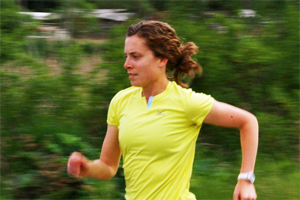
Dr. Phil Ainslie outside of the Pyramid Laboratory at Mount Everest.
By: Nikki Reiter
The Rift Valley in Kenya, the Sierra Terahumara in Mexico, and the tiny towns of the Himalayas all boast a common thread: they are a breeding ground for top endurance performances. The altitude of these areas provides a training effect that allows locals to achieve running performances most of us couldn’t imagine. Dr. Phil Ainslie is an Associate Professor at the University of British Columbia Okanagan and has recently returned from leading a research expedition to the Mount Everest Pyramid Laboratory, where he and his team of researchers performed experiments that tested the effects of altitude on multiple physiological variables. Most days, Dr. Ainslie can be seen running or biking to the University, and he ran daily as part of his physical preparation leading up to the expedition.
The Benefits
Altitude training is thought to provide a stimulus to increase the body’s concentration of erythropoietin (or more commonly known as ‘EPO’). Endurance athletes, in particular, will benefit because EPO will increase the number of red blood cells in the body, which are responsible for carrying oxygen to working muscles. Oxygen delivery to muscles no longer becomes the limiting factor for exercise and thus an athlete running any endurance event can work harder and longer.
Unfortunately, not everyone responds to the exposure to hypoxic (low oxygen) conditions with improved aerobic performances. Dr. Ainslie explains that, “whereas some studies show minor improvement, others report no change or even worsening. Furthermore, the mechanisms behind the proposed beneficial changes remain obscure and are far from being proven.”
Live High, Train Low
Maximal oxygen consumption is reduced by around 10% per 1000 m of elevation. Because of the lack of oxygen as altitude increases, it’s difficult to workout at maximum intensity (as you would at sea level), which has negative implications if you’re trying to hit specific splits on the track or on the road. That’s why runners will aim to live and sleep at altitude or in an artificially produced hypoxic condition, such as altitude tents or masks.
In order to achieve a benefit, Dr. Ainslie explains that “habituating at altitude must be for more than 12 hours per day and for at least 3 weeks. With this technique, some improvements in sea-level performance have been shown in events lasting between 8 and 20 minutes. However, as mentioned, there is a lack of sufficiently powered randomized, double-blinded studies, with training protocols that are identical for all groups.”
The effects of altitude are not permanent either; red blood cell concentrations return to pre-altitude exposure within 3-9 days spent at sea level.
The Drawbacks
Living at altitude sound too good to be true? Well, it just might be. For those of us not accustomed to the ‘thin air,’ poor sleep, headaches and nausea are symptoms likely to accompany the ascent in altitude above 3000 m.
At the elite level, many athletes have been caught for doping by increasing their EPO concentrations beyond normal values by injecting artificially synthesized EPO or by blood doping. Both practices are not only illegal, but dangerous. Specifically, blood doping can increase the thickness of blood, making it harder for the body to pump it at rest. To avoid this fatal implication, athletes who engage in blood doping have been known to awake in the middle of the night to cycle to get blood flowing again.
“Nevertheless, many elite athletes and their coaches strongly believe in altitude training for competition at sea level” says Ainslie and that because “runners from, for example, Kenya (located at 2000-3000 m) are well known for their superior endurance performance at sea level and thus, some benefits of high altitude training cannot be excluded.”
Bottom line is that there are a great number of ways to improve one’s performance at sea level before taking up altitude training. Consistent training by exhausting the traditional methods of incorporating interval training, aerobic running and improving running mechanics will still lead to improvements in running performance.
Happy Running!
***
 Nikki Reiter holds a master’s degree in biomechanics and is a Mizuno Running Brand Ambassador and the Women’s Cross Country Running Head Coach at the University of British Columbia Okanagan campus in Kelowna, BC. She is also the Laboratory Coordinator in the School of Health and Exercise Sciences at UBC Okanagan where she facilitates undergraduate laboratory learning.
Nikki Reiter holds a master’s degree in biomechanics and is a Mizuno Running Brand Ambassador and the Women’s Cross Country Running Head Coach at the University of British Columbia Okanagan campus in Kelowna, BC. She is also the Laboratory Coordinator in the School of Health and Exercise Sciences at UBC Okanagan where she facilitates undergraduate laboratory learning.






 Current Issue
Current Issue Previous Issue
Previous Issue Prior Release
Prior Release
